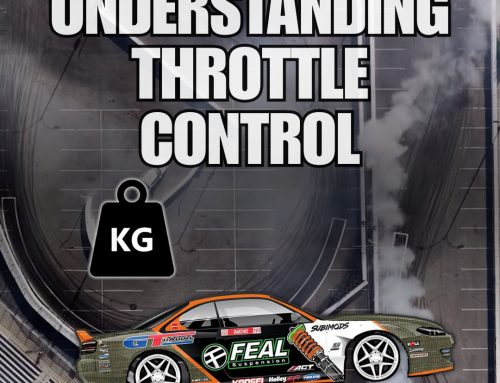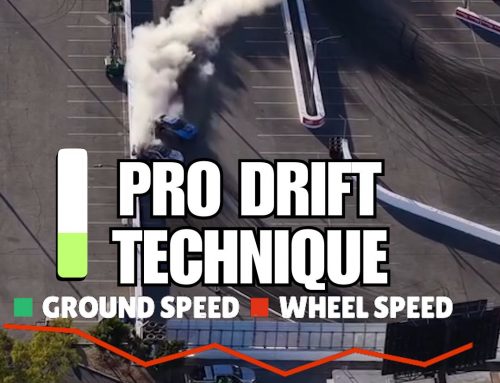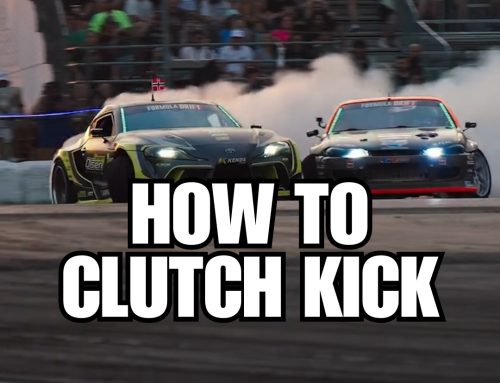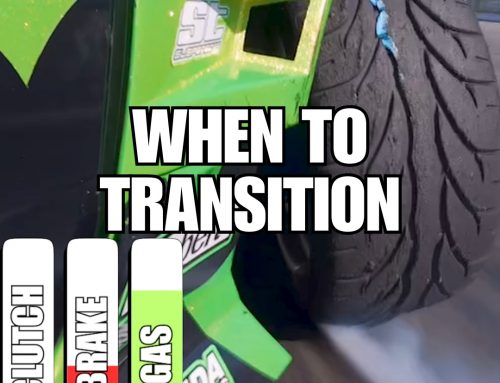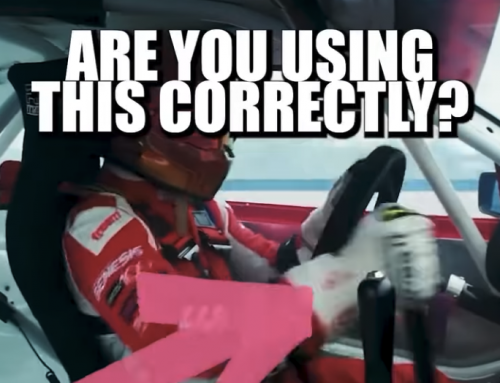We have advanced drifters and race car drivers as students. And we have students who have never heard of “drifting”. So, we put together this list (may not be comprehensive) of terms related to drifting to serve as a reference guide if there’s a word you’ve never heard before. Hope this is helpful. And if there’s a term you don’t see on here, drop us a line!
- Angle kit: A modification to the car’s suspension that allows for more steering angle, making it easier to initiate a drift.
- Apex: The point on a track where the car is closest to the inside edge of a turn.
- Caster Angle: The angle at which the steering axis tilts forward or backward.
- Chase car: The car that follows the lead car during a tandem drift.
- Chase View: A camera angle that follows behind the drifting car, showing the driver’s perspective.
- Chassis Balance: The balance of weight distribution and suspension settings that affect the car’s handling during a drift.
- Clipping Point: A point on the track used to drift around a corner.
- Clipping Zone: A section of the track used to drift around a corner.
- Clutch kick: A technique where the driver keeps the accelerator all the way down and hits the clutch, creating a “kicking” motion to maintain and initiate a drift, especially in lower-powered cars.
- Counter steer: The technique of steering in the opposite direction of the turn in order to initiate and maintain a drift.
- Drift Angle: The angle at which the car is drifting, relative to the turn.
- Drift Circuit: A type of race track specifically designed for drifting competition.
- Drift Compression: The suspension movement that occurs as a car enters a turn and begins drifting.
- Drift Donut: A maneuver where the car spins in circles while drifting.
- Drift Knuckles: Modified suspension parts that allow for greater steering angle and improved handling during drifting.
- Drift limiter: A device that limits the maximum speed of the car while drifting to prevent excessive wheel spin or power.
- Drift line: The path that a drifting car takes on the track, including the angle and trajectory of the car.
- Drift Machine: A term to refer to a car that is built specifically for drifting and have been modified accordingly.
- Drift missile : A type of drift car where the front and rear wheelbase are different, typically with the rear wheelbase being shorter than the front wheelbase.
- Drift Setup: The specific modifications and adjustments made to a car to optimize it for drifting.
- Drift Taxi: A car ride service where customers pay to ride shotgun in a drifting car driven by a professional driver
- Drift Triangle: A technique where the driver links three turns together in a triangular pattern.
- E-brake: An emergency brake, mostly used for drifting to lock the rear wheels for initiation.
- Entry or initiation: The start of a turn or drift, the point at which the driver initiates the drift.
- Feather throttle : Gradually easing off the throttle pedal
- Feint: A steering input used to initiate a drift.
- Gymkhana: A motorsport that combines elements of drift, precision driving, and obstacle course racing.
- Handbrake Turn: An entry method for a drift that uses the handbrake to abruptly lock the rear wheels and initiate the drift.
- Inertia Drift: Drifting technique where the car is in a state of oversteer, initiated by the inertia of the car instead of the throttle.
- Lead car: The car in front of the chasing car during a tandem drift.
- Line choice: The specific path that a driver chooses to take through a turn or course.
- Line Control: The act of controlling the trajectory of the car during a drift.
- Linking turns: Drifting through multiple turns without losing drift angle or speed.
- Lockup: When brakes are applied and the wheels stop rotating.
- Manji: A technique where the driver swerves in and out of two corners, linking them in a fluid motion.
- Oversteer: A condition where the rear wheels lose traction, causing the rear of the car to slide out.
- Power Over: A drifting technique where the driver applies power to the wheels while the car is in a state of oversteer.
- Powerslide: A type of drift where the driver maintains a high level of throttle throughout the drift.
- Proximity: The distance between a drifting car and the wall or other cars on the track.
- Scandinavian Flick: A technique used while drifting, which involves a sudden steering lock and a flick of the car into the corner.
- Snap Oversteer: A sudden and dramatic loss of rear traction, causing the rear of the car to lose control.
- Steering Angle: The angle of the front wheels of the car in relation to the centerline of the car
- Style: The individualized way a driver executes a drift or a maneuver
- Tandem drifting: A type of drifting where two cars drift alongside each other, following each other’s lines.
- Throttle Steer: A drifting technique where the driver uses the throttle to control the angle of the drift.
- Toe-in: The angle at which the front wheels of a car point towards each other.
- Toe-out: The angle at which the front wheels of a car point away from each other.
- Transition: The movement from one drift angle to another.
- Understeer: A condition where the front wheels lose traction, causing the front of the car to slide out
- Wall tap/wall ride: A maneuver where the driver lightly grazes a wall with the back bumper, leaving a mark as a “badge of honor.” A wall ride is similar, but the car stays in contact with the wall for longer.
- Weight jacking: A technique where the driver manipulates the weight distribution of the car to improve grip, commonly transferring weight to the rear of the car.
- Welded diff: A modification to the car’s differential where the gears are welded together, causing the rear wheels to move at the same speed, which can help the car initiate a drift.
- Wheel Hop: when the wheel loses contact with the ground and “hops” or skips on the surface, commonly caused by too much power or hard shifting.
